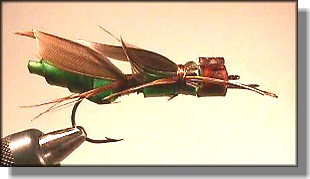|
Prairie Hopper
Let me begin by saying that never in my wildest dreams did I think that this fly would be selected for Honorable Mention in the Millennium Fly Contest. The picture that you are looking at doesn't do this fly justice. This is one ugly fly. It's saving grace is that with ugly comes simplicity, it is a very easy fly to tie.
I haven't as yet had an opportunity to put one of these in the water, but the thought behind it was that I wanted a fly that gave about the same silhouette as a real hopper and I think this does. This fly is fashioned after the American Bird Grasshopper. The range of these hoppers is from the Rocky Mtn., across Nebraska and Tennessee and up into New York. They range in size from 40 to 55 mm. or 1.5 to 2.2 inches.
Materials List:
Hook: 1/0.
Thread: Brown 6/0,
Body extension: 316L welding rod.
Body: Double stick foam tape, 3M brand.
Wing: Mallard duck wing, brown.
Legs: Pheasant barbles.
|



